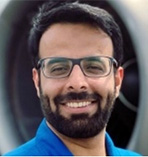
Khalifa University
Dr Yarjan Abdul Samad is an Assistant Professor of Aerospace Engineering at Khalifa University, UAE and a Senior Research Associate and Senior Teaching Fellow at The University of Cambridge. He is also the Chief Technology Advisor to a climate change company called Levidian based out of Cambridge, UK, which is transforming waste gas resources to graphene and hydrogen. His research work is based on developing graphene & 2d materials-based technologies for Space and Aerospace. He was among the team of scientists on European Space Agency (ESA)’s Zero Gravity flights who were the first to test Graphene in microgravity. He has also tested graphene-based materials for applications in space using Sounding Rockets. He is a member of the Science Team of Rashid Rover, which is due for launch within 2022, by MBRSC, UAE. He is the recipient of several awards such as Young Leaders Award 2020 by the UK’s Young Professional Society, The Innovator of The Year by the technology development company, Pakistan foreign affairs award for twenty-five under the age of 40 talents of Pakistani origin abroad, The Outstanding Research Reviewer of the year 2017 by the Royal Society of Chemistry UK, Nano Today Best Scientific Presentation, and many other Best Scientific Talks awards at international conferences. In addition to research, he has taught parts of a graduate course on graphene technology at the University of Cambridge. He is a proud graduate of Khalifa University. Prior to moving abroad, he obtained his bachelor’s degree in engineering from Ghulam Ishaq Khan Institute (GIKI) in Pakistan. He graduated from GIKI with two gold medals (one for best academic performance and another for best overall performance).
Two-dimensional (2D) materials flakes offer a range of exploitable electrical, thermal, and mechanical properties that make them attractive as performance enhancing additives, especially in energy storage, composites, inks, and coatings among others [1-4]. Thus far, the most promising method for affordable, industrial scale 2D flake production is liquid phase exfoliation (LPE). However, the state-of-the-art LPE techniques have challenges including but not limited to purification processes, large solvent volumes due to lower concentrations, unexfoliated material waste due to lower yield, lower flake sizes (typically hundreds of nanometres) and inadequate bulk characterization techniques, which lead to the widespread unreliability of 2D materials product specifications, increased costs, and limited process-property control [5].
Here I will talk about the production of 2D materials inks and suspensions via High Pressure Homogenization (HPH) based techniques [6] with a capability of producing flakes at higher concentrations (> 500 g/L) with no post-processing or purification and with semi-controllable properties. Through post solvent exchange 2D materials inks and suspensions can be produced nearly in any solvent. 2D materials such as graphene, hexagonal boron nitride and molybdenum disulphide are produced in water, ethanol, isopropanol, and for the first time in unconventional solvents such as hydrofluoroether (HFE) without fluorine functionalization. HFE is chosen due to its safety features in Space applications [7]. The use of these 2D materials inks suspended uniformly in HFE in microgravity conditions is demonstrated aboard sounding rockets (MASER14, and MASER15) [8, 9].